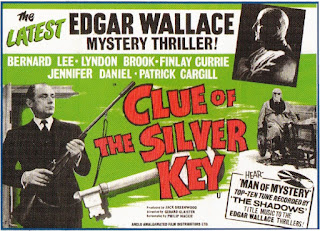A Stranger in Town is a very low-key 1957 British crime picture. In fact I don’t think you could find a more low-key crime film than this one.
The movie opens with the apparent suicide of a young American composer, David Vernon, who has been living in a sleepy English village. Not long afterwards another young American arrives. John Madison (Alex Nicol) is a reporter but he’s on holiday. Vernon’s uncle had asked him to visit the village to try to piece together the last few days of his nephew’s life and perhaps find the explanation for his suicide. John Madison isn’t a cop or a private eye and he isn’t suspicious at all about the circumstances of Vernon’s death.
The usual formula in these types of mysteries is that the investigator soon comes to believe that the suicide was actually murder, and his big task is then to convince the police that his suspicions are correct. In this case though Madison remains convinced that Vernon’s death really was a suicide. He’d just like to find out what drove the young composer to take his own life.
The village is somewhat divided over the presence of this second stranger. Vicki (Anne Paige), who’d been in love with David Vernon, seems to resent Madison’s presence. Her uncle and guardian, Henry Ryland (Colin Tapley), is not sure what to think. Henry Ryland owns the village’s only hotel, its only newspaper, and in fact seems to own most of the village. His brother William (Bruce Beeby) definitely resents what he sees as Madison’s prying. William Ryland is a rather obnoxious drunk and he obviously has designs on Vicki. William’s interest in Vicki must have caused some tensions with Vernon but it’s difficult to see how this could lead to the latter’s suicide.
Madison slowly comes to realise that David Vernon wasn’t quite the innocent young American that he’d assumed, but he also comes to realise that his suicide is actually rather difficult to explain.
The village is of course a hotbed of gossip but village life is neither idealised nor demonised in this movie. Some of the villagers are surly and very unfriendly to strangers; some are open and welcoming. Some are thoroughly unpleasant people; others are very decent and very kindly.
Alex Nicol underplays his role to an extraordinary degree. In a way this works - it focuses our attention on the victim (who is after all what the story is all about) rather than the amateur investigator. Anne Paige is quite good as Vicki, a rather conflicted and confused young woman. Bruce Beeby plays William Ryland, effectively enough, as an arch-cad.
In supporting roles the standout performers are Mona Washbourne as the delightful amateur poetess Agnes Smith and Charles Lloyd Pack as the slightly Colonel Blimp-ish Captain Nash. Despite his attempts to convey a proper military bearing Nash is rather fond of a drink and even more fond of one if someone else is paying. These two not only lighten the mood but also make the portrayal of the village more realistic - there will always be some surly types in any community but there will also always be jovial if slightly ridiculous figures as well.
Director George Pollock was best known for light-hearted romps such as the Margaret Rutherford Miss Marple movies. With A Stranger in Town there’s no overt comedy but Pollock does display the same affection for English rural life. In fact A Stranger in Town is very much like one of the Rutherford Miss Marple movies without the comic elements. Writer Norman Hudis is best remembered for the early Carry On movies although he also wrote the script for the fine crime thriller/heist movie The Flying Scot (released in the same year as A Stranger in Town).
This movie doesn’t feel quite as studio-bound as most low-budget British crime films of its era. There’s just enough location shooting to make it less stifling and claustrophobic. Of course some crime movies benefit from being stifling and claustrophobic but this one is very much a bucolic mystery and it needs the more open feel.
Renown Pictures in the UK have released this movie as part of a three-movie all-region DVD set (the other movies being The Third Alibi and Night Was Our Friend). It’s a single-disc set but with each movie running for just over an hour there are no problems at all and the transfers are quite satisfactory, apart from some intermittent sound issues with A Stranger in Town (happily all the dialogue is still quite understandable). Although there are no extras the set is superb value for money. The Third Alibi is excellent, Night Was Our Friend is interesting and pretty good and while A Stranger in Town is the weakest of the three it’s enjoyable enough.
A Stranger in Town is an unassuming little mystery. If you buy the set for the other two movies there’s no reason not to give this one a spin as well. Recommended.



















